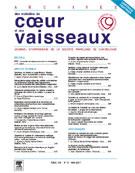05-41 - PARADOXICAL LOW FLOW, LOW GRADIENT SEVERE AORTIC STENOSIS DESPITE PRESERVED EJECTION FRACTION IS ASSOCIATED WITH HIGHER AFTERLOAD AND REDUCED SURVIVAL - 09/04/08
Background: Recent studies and current clinical observations suggest that some patients with severe aortic stenosis (AS) on the basis of valve effective orifice area may paradoxically have a relatively low gradient despite the presence of a preserved left ventricular (LV) ejection fraction.
Objective: To document the prevalence, potential mechanisms, and clinical relevance of this phenomenon.
Methods: We retrospectively studied the clinical and Doppler-echocardiographic data of 512 consecutive patients with severe AS (indexed AVA < = 0.6cm2/m2) and preserved LV ejection fraction (LV EF > = 50%).
Results: Of these patients, 331 (65%) had normal LV flow output (NF group) defined as a stroke volume index (SVI) > 35ml/m2 and 181 (35%) had paradoxically low flow output (PLF group) defined as SVI < = 35ml/m2. When compared to NF patients, PLF patients had a higher prevalence of female gender (p < 0.05), a lower transvalvular gradient (32 ± 17 vs. 40 ± 15 mmHg; p < 0.001), a lower LV diastolic volume index (52 ± 12 vs. 59 ± 13 ml/m2; p < 0.001), lower LV ejection fraction (62 ± 8 vs. 68 ± 7%; p < 0.001), a higher level of LV global afterload reflected by a higher valvulo-arterial impedance (Zva) (5.3 ± 1.3 vs. 4.1 ± 0.7 mmHg. ml-1.m-2; p < 0.001) and a lower overall 3-year survival (76% vs. 86%, p = 0.006). Only age (hazard ratio: 1.06 (95% CI: 1.02-1.09); p = 0.0006) and Zva > = 5.5 mmHg. ml-1.m-2, (hazard ratio: 2.5 (95% CI: 1.1-5.3); p = 0.02) were independently associated with increased mortality.
Conclusion: Patients with severe AS may have low transvalvular flow and low gradients despite normal LV ejection fraction. A comprehensive evaluation shows that this pattern is in fact consistent with a more advanced stage of the disease and has a poorer prognosis. Such findings are clinically relevant since these patients may often be misdiagnosed and inappropriately treated.
© 2007 Elsevier Masson SAS. Tous droits réservés.
Vol 100 - N° 12
P. 1082 - décembre 2007 Retour au numéroBienvenue sur EM-consulte, la référence des professionnels de santé.

